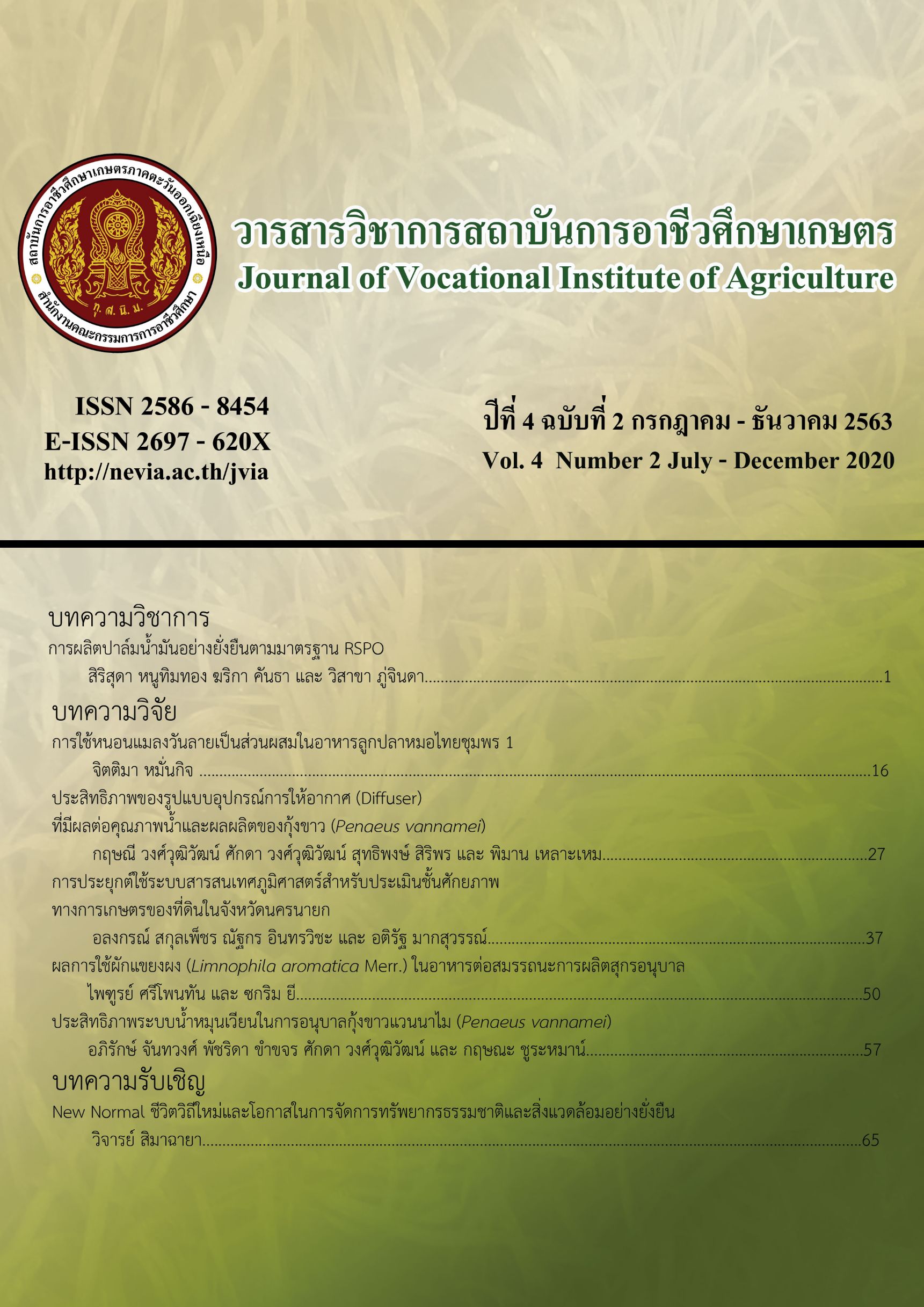Efficiency of Aeration Models (Diffuser) on Water Quality and Pacific White Shrimp (Penaeus vannamei) Production
Main Article Content
Abstract
This study aims to compare an efficiency of two different diffuser models, used in pacific white shrimp tarpaulin rearing pond with 15 meters in diameter. There were two treatments with two replications including 1) tube diffuser which normally used in shrimp farms and 2) diffuser panel with water direction controlling developed by researchers. Three parameters were examined including dissolved oxygen, ammonia, sediment amount/unit area, growth rate (average weight and average daily growth (ADG)) and survival rate. Shrimp post larvae (PL.12) were stocked for 30 days with the density of 1,132 pieces/cubic meter.
The study results indicated that shrimp growth rate and sediment amount/unit area were significantly different at 0.05 level between 2 treatments which average weight, average daily growth (ADG) in the developed diffuser (1.27±0.01 g and 0.0426±0.70 g) were higher than another treatment (1.20±0.01 and 0.0375±0.08 g). The sediment amount/unit area also showed the better result which was 0.017± 0.00 kg/m2 compared to the 1st treatment (0.021± 0.00 kg/m2). However, there were not significantly different, between the 1st and 2nd treatment, foundin the rest of parameters including dissolved oxygen (6.36±0.11 and 6.46±0.09 mg/l), ammonia (0.01±0.14 and 0.05±0.57 mg/l) and survival rate (86.44±1.00 and 86.73±1.00 %) respectively.
In conclusion, the results indicated that the developed diffuser panel with water direction controlling showed higher efficiency resulting from sediment can be moved to pond center and easily to get rid of which lead to higher growth rate. Therefore, this model could be another type of diffuser to be recommended for pacific white shrimp production.
Article Details
The content and information in articles published in the Journal of Vocational Education in Agriculture are the opinions and responsibility of the article's author. The journal editors do not need to agree or share any responsibility.
Articles, information, content, etc. that are published in the Journal of Vocational Education in Agriculture are copyrighted by the Journal of Vocational Education in Agriculture. If any person or organization wishes to publish all or any part of it or to do anything. Only prior written permission from the Journal of Vocational Education in Agriculture is required.
References
กองนโยบายและยุทธศาสตร์พัฒนาการประมง. (2562). สถานการณ์สินค้ากุ้งทะเลและผลิตภัณฑ์ในช่วง 6 เดือนแรกของปี 2562. กรุงเทพฯ: กรมประมง กระทรวงเกษตรและสหกรณ์.
ณาตยา ศรีจันทึก. (2561). สถานการณ์สินค้ากุ้งทะเลและผลิตภัณฑ์ปี 2561. กรุงเทพฯ: กรมประมง กระทรวงเกษตรและสหกรณ์.
ชลอ ลิ้มสุวรรณ และ พรเลิศ จันทร์รัชชกุล. (2547). อุตสาหกรรมการเพาะเลี้ยงกุ้งในประเทศไทย. กรุงเทพฯ: สำนักงานคณะกรรมการวิจัยแห่งชาติ.
Schuler D. J., (2008). Acute toxicity of ammonia and nitrite to white shrimp (L. vannamei) at low salinities. (Master thesis). Virginia: Virginia Polytechnic Institute and State University.
วัฒนา วัฒนกุล และคณะ. (2552). การวิจัยและพัฒนาการเลี้ยงกุ้งขาวแวนนาไมโดยการเปรียบเทียบวิธีการเลี้ยงแบบพัฒนาหนาแน่นสูงที่แตกต่างกัน 2 วิธี (รายงานการวิจัย). ตรัง: คณะวิทยาศาสตร์และเทคโนโลยีการประมง มหาวิทยาลัยเทคโนโลยีราชมงคลศรีวิชัย.
อุตสาหกรรมกุ้งไทย. (ม.ป.ป.). การเพาะเลี้ยงกุ้งขาวแวนนาไม. เข้าถึงได้จาก http://www.thailand shrimp.org/agriculture_vannamei8.html
บริษัทเบทาโกร จำกัด มหาชน. (ม.ป.ป.). คู่มือการเลี้ยงกุ้งขาว. เข้าถึงได้จาก http://betagrofeed .com/community/wp-content/uploads/2014/12
ชลอ ลิ้มสุวรรณ และคณะ. (2555). ผลของการนำสารอินทรีย์และเลนออกจากบ่อโดยท่อระบายกลางบ่อต่อการเจริญเติบโตและอัตรารอดตายของการเลี้ยงกุ้งขาวแวนนาไมอย่างหนาแน่น. การประชุมทางวิชาการของมหาวิทยาลัยเกษตรศาสตร์ ครั้งที่ 50 (น. 428-436). กรุงเทพฯ: มหาวิทยาลัยเกษตรศาสตร์
ชวลิต อัครคหสิน และคณะ. (2552). ประสิทธิภาพของระบบฉีดออกซิเจนแบบใหม่ในการเลี้ยงกุ้งขาวแวนนาไม (Litopenaeus vannamei). การประชุมทางวิชาการของมหาวิทยาลัยเกษตรศาสตร์ ครั้งที่ 47 (น. 133-141). กรุงเทพฯ: มหาวิทยาลัยเกษตรศาสตร์

